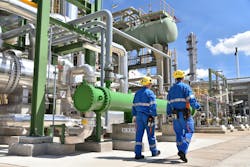Workforce Matters: Recognizing Change’s Role in Safety Incidents
Leadership commitment and a robust safety culture are key to driving these initiatives and ensuring the safety of all personnel involved.
Proactive Monitoring of Facility Conditions
- Continuous Monitoring Systems: Advanced monitoring systems can continuously track key parameters such as temperature, pressure and chemical concentrations.
- Use of Technology: Leveraging technologies like custom sensors, real-time data analytics and machine learning can enhance a facility’s ability to detect anomalies and predict potential issues before they escalate.
- Regular Inspections and Audits: Scheduled inspections and audits by trained personnel can identify changes or deviations from standard operating procedures.
Identifying Potential Hazards
- Hazard Identification Methods: Techniques such as Hazard and Operability Studies (HAZOP), Failure Mode and Effects Analysis (FMEA), and risk assessments can help to identify potential hazards in both processes and equipment/machinery.
- Employee Training and Awareness: Employees can be trained to recognize signs of potential hazards and understand the importance of reporting changes or abnormalities immediately.
- Safety Culture: Fostering a safety culture where employees feel empowered to speak up about potential risks without fear of retaliation is essential.
Making Adjustments as Needed
- Standard Operating Procedures (SOPs): SOPs should include protocols for responding to identified changes and potential hazards. These procedures need to be reviewed regularly and updated based on new information or incidents.
- Emergency Response Plans: High-risk facilities must have comprehensive emergency response plans that detail steps to be taken in the event of an identified risk or change in conditions.
- Communication and Coordination: Effective communication and coordination amongst different departments and teams within a facility are vital for timely and efficient responses to changes.
The Role of Leadership and Management
- Leadership Commitment: Leaders should demonstrate a commitment to safety by allocating resources for monitoring and safety training and by fostering a sustainable culture of continuous improvement.
- Decision-Making Processes: Decision-making processes should be data-driven, with a focus on safety and risk mitigation. Regular reviews of safety performance and incident reports can guide improvements.
- Feedback Loops: Establishing feedback loops where employees can share opinions, insights and experiences helps in continuously refining safety measures and protocols.
Challenges and Solutions
- Resource constraints: Prioritize high-impact areas and leverage cost-effective technologies to address the challenge of limited resources for monitoring and safety improvements.
- Resistance to change: Overcome resistance to change through training and awareness programs and demonstrate the benefits of proactive safety measures.
- Data management: Managing the vast amount of data generated by monitoring systems can be challenging. Implementing robust data management systems and analytics tools can help in making sense of the data and identifying actionable insights.
Key Takeaways
About the Author
Lauren Neal
Founder and Chief Program Creator, Valued at Work
Lauren Neal is the Founder of Valued at Work – a consultancy that creates workplace cultures where no one wants to leave, in traditionally male-dominated sectors.
Since 2005, Lauren has worked as an engineer and project manager in the energy sector offshore, onshore and onsite on multimillion-dollar projects across the globe. Chartered through both the Institution of Engineering and Technology (IET) and the Association of Project Management (APM), Lauren is a sought-after speaker, writer, and consultant championing career progression within STEM and inclusive workplace cultures beyond the boundaries of demographics.
Lauren’s book released in October 2023 – 'Valued at Work: Shining a Light on Bias to Engage, Enable, and Retain Women in STEM' – became an Amazon #1 best-seller and is a finalist in the 2024 Business Book Awards.
Click here to reach out to Lauren.

